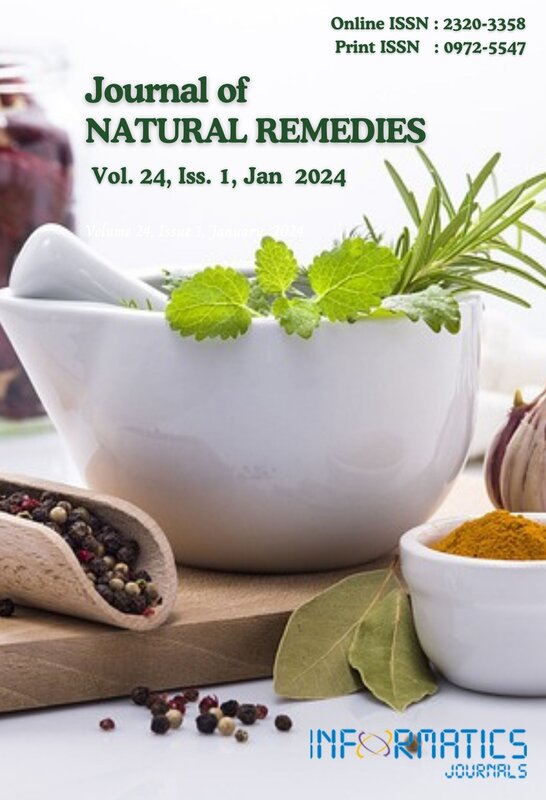Investigation of Anthelmintic Potential of Two Leafy Vegetables from the Amaranthaceae Family
DOI:
https://doi.org/10.18311/jnr/2024/34714Keywords:
Albendazole, Amaranthus tricolor Linn., Amaranthus viridis Linn., Anthelmintic Activity, Earthworm, Eisenia fetidaAbstract
Objective: The present study investigates the anthelmintic potential of Amaranthus viridis Linn. and Amaranthus tricolor Linn. (Amaranthaceae) leafy vegetables from the Pune district, traditionally used as vermicides. Materials and Methods:The ethyl acetate, acetone and ethanol leaf extracts of both plants were subjected to preliminary investigations for thephytochemical elements. The anthelmintic activity of these extracts was tested against fully-grown Eisenia fetida earthworms.Ethyl acetate extract of A. viridis L. and acetone extract of Amaranthus tricolor L. showed the presence of all phytochemicals.Doses of 10–30 mg/ml were used in bioassay. Time of paralysis and death of earthworms was observed. Results: All extractsexhibited considerable dose-dependent activity against the reference drug, showing maximum activity at 30 mg/mL in bothplants. The most promising activity was exhibited by the ethyl acetate extract of the A. viridis L. (P (min.) = 4, D (min.) =5), followed by the acetone extract of the A. tricolor L. (P (min.) = 6, D (min.) = 13). Albendazole (20 mg/ml) and normalsaline were applied as a standard drug and control, respectively. High concentrations of alkaloids, tannins, and phenolicphytochemicals might be responsible for the exceptional activity. Conclusion: The present work scientifically validates thetraditional use and concludes that ethyl acetate and acetone extracts may be further processed to isolate the compoundsresponsible for said activity. One-way ANOVA with a significance level of 5% was used to validate the data (n = 3, p < 0.05).
Downloads
Metrics
Downloads
Published
How to Cite
Issue
Section
License
Copyright (c) 2024 Manju Tripathi, Vaishali B. Adsul, E. Khatiwora, M. P. Wadekar, S. A. Gaikwad (Author)

This work is licensed under a Creative Commons Attribution 4.0 International License.
Accepted 2023-10-20
Published 2024-01-01
References
Pullan RL, Smith JL, Jasrasaria R, Brooker SJ. Globalnumbers of infection and disease burden of soil transmittedhelminth infections in 2010. Parasites Vectors. 2014; 7:37.https://doi.org/10.1186/1756-3305-7-37 PMid:24447578PMCid:PMC3905661 DOI: https://doi.org/10.1186/1756-3305-7-37
WHO newsroom: Soil-transmitted helminth infections.Available from: https://www.who.int/news-room/fact-sheets/detail/soil-transmitted-helminth-infections
Adamson ML, Anderson RC. Review of nematode parasitesof vertebrates. Their Development and Transmission, byRC Anderson. Journal of Parasitology. 1993; 79(4):634-35.https://doi.org/10.2307/3283397 DOI: https://doi.org/10.2307/3283397
Gilman JG, Hardman JG, Limbird LE. The Pharmacologicalbasis of therapeutics, 10th Edn. United States of America:McGraw-Hill Medical Publishing Division; 2001. p. 450-55.
Vercruysse J, Albonico M, Behnke JM, Kotze AC, PrichardRK, McCarthy JS, et al. Is anthelmintic resistance a concernfor the control of human soil-transmitted helminths.International Journal for Parasitology: Drugs and DrugResistance. 2013; 1:14-27. https://doi.org/10.1016/j.ijpddr.2011.09.002 PMid:24533260 PMCid:PMC3913213 DOI: https://doi.org/10.1016/j.ijpddr.2011.09.002
Jayawardene KLTD, Palombo EA, Boag PR. Natural productsare a promising source for anthelmintic drug discovery.Biomolecules. 2021; 11(10). https://doi.org/10.3390/biom11101457 PMid:34680090 PMCid:PMC8533416 DOI: https://doi.org/10.3390/biom11101457
Jain P, Singh S, Singh SK, Verma SK, Kharya MD, SolankiS. Anthelmintic potential of herbal drugs. InternationalJournal of Research and Development in Pharmacy and LifeSciences. 2013; 2(3):412-27.
Peter K, Gandhi P. Rediscovering the therapeutic potentialof Amaranthus species: A review. Egyptian Journal of Basicand Applied Sciences. 2017; 4(3):196-205. https://doi.org/10.1016/j.ejbas.2017.05.001 DOI: https://doi.org/10.1016/j.ejbas.2017.05.001
Fajimi, AK, Taiwo AA. Herbal remedies in animalparasitic diseases in Nigeria: A review. African Journal ofBiotechnology. 2005; 4(4):303-7.
Khare, CP. Indian medicinal plants. An illustrated dictionary.Springer; 2007. p. 41. https://doi.org/10.1007/978-0-387-70638-2 PMCid:PMC2705749 DOI: https://doi.org/10.1007/978-0-387-70638-2
Council of Scientific and Industrial Research (CSIR).Publications and Information Directorate. The Wealth ofIndia. Vol. 1. Publications and Information directorate.New Delhi: CSIR; 1988. p. 219.
Kiritikar KR, Basu BD. Indian medicinal plants. Vol. 3, 2ndEdn., New Delhi: Archaeological Survey of India; 1987. p.2061-62.
Council of Scientific and Industrial Research (CSIR).Publications and Information Directorate. The Wealth ofIndia. Vol. 1. A Dictionary of Indian raw materials andindustrial products. New Delhi; 1988. p. 221.
Reyad-ul-Ferdous M, Shahjahan DS, Tanvir S, Mukti M.Present biological status of potential medicinal plant ofAmaranthus viridis: A comprehensive review. AmericanJournal of Clinical and Experimental Medicine. 2015; 3(5):12-17. https://doi.org/10.11648/j.ajcem.s.2015030501.13 DOI: https://doi.org/10.11648/j.ajcem.s.2015030501.13
Bharathi DR, Sahana KG, Mahesh C, Babu A, Karthik S,Kumar R, et al. Phytochemical composition and therapeuticeffects of Amaranthus viridis Linn.: A review. InternationalJournal of Indigenous Herbs and Drugs. 2022; 8:110-13.https://doi.org/10.46956/ijihd.v7i6.370 DOI: https://doi.org/10.46956/ijihd.v7i6.370
Ayurvedic Pharmacopoeia of India. Government of India,Ministry of Health and Family Welfare, Department of ISMand H. Part 1, 3; 2001. p. 159. Available from: http://www.ayurveda.hu/api/API-Vol-3.pdf
Srivastava R. An updated review on phyto-pharmacologicaland pharmacognostical profile of Amaranthus tricolor: Aherb of nutraceutical potentials. The Pharma InnovationJournal. 2017; 6:124-9.
Baraniak J, Kania-Dobrowolska M. The dual nature ofamaranth-functional food and potential medicine. Foods.2022; 11(4):618. https://doi.org/10.3390/foods11040618PMid:35206094 PMCid:PMC8871380 DOI: https://doi.org/10.3390/foods11040618
Baral M, Chakraborty S, Chakraborty P, Roy B. Evaluationof anthelmintic and anti-inflammatory activity ofAmaranthus spinosus Linn. International Journal of CurrentPharmaceutical Research. 2010; 2(4):44-7.
George B, Kousalya P. In vitro anthelmintic efficacy ofAmaranthus dubius, Basella alba and Cleome gynandra. DerPharma Chemica. 2018; 10(6):142-8.
Kumar BS, Lakshman K, Jayaveera KN, Velmurugan C,Manoj B, et al. Anthelmintic activity of methanol extract of Amaranthus caudatus Linn. Internet Journal of Food Safety.2010; 12:127-9.
Kumar ABS, Lakshman K, Jayaveera KN, Nandeesh R, ManojB, Ranganayakulu D. Comparative in vitro anthelminticactivity of three plants from the Amaranthaceae family.Archives of Biological Sciences. 2010; 62(1):185-9. https://doi.org/10.2298/ABS1001185K DOI: https://doi.org/10.2298/ABS1001185K
Khandelwal KR. Practical pharmacognosy technique andexperiments, 2nd Edn., Nirali Prakashan, Pune; 2000. p.149-56.
Mali RG, Wadekar RR. In vitro anthelmintic activityof Baliospermum montanum Muell: Arg roots. IndianJournal of Pharmaceutical Sciences. 2008; 70:131-3.https://doi.org/10.4103/0250-474X.40352 PMid:20390101PMCid:PMC2852054 DOI: https://doi.org/10.4103/0250-474X.40352
Sollamann T. Anthelmintics: Their efficacy as tested onearthworm. Journal of Pharmacology and ExperimentalTherapeutics. 1918; 12:129-70.
Bate-Smith EC. The phenolic constituent of plants and theirtaxonomic significance, dicotylendons. The Journal of the Linnean Society. Botany. 1962; 58(371):95-103. https://doi.org/10.1111/j.1095-8339.1962.tb00890.x DOI: https://doi.org/10.1111/j.1095-8339.1962.tb00890.x
Roy H, Chakraborty A, Bhanja S, Nayak BS, Mishra SR, EllaiahP. Preliminary phytochemical investigation and anthelminticactivity of Acanthospermum hispidum DC. Journal ofPharmaceutical Science and Technology. 2010; 2(5):217-21.
Mukherjee N, Mukherjee S, Saini P, Roy P, Sinha BabuSP. Phenolics and terpenoids; the promising new searchfor anthelmintics: A critical review. Journal of MedicinalChemistry. 2016; 16:1415-41. https://doi.org/10.2174/1389557516666151120121036 PMid:26586122 DOI: https://doi.org/10.2174/1389557516666151120121036
Mute VM. Anthelmintic effect of Tamarind indica Linn.leaves juice exract on Pheretima posthuma. InternationalJournal of Pharmaceutical Research and Development.2009; 7:1-6.
Martin RJ. Gamma-amino butyric acid and piperazineactivated single channel current from Ascaris suum bodymuscle. British Journal of Pharmacology. 1985; 84(2):445-61. https://doi.org/10.1111/j.1476-5381.1985.tb12929.xPMid:2579701 PMCid:PMC1987283 DOI: https://doi.org/10.1111/j.1476-5381.1985.tb12929.x

 Manju Tripathi
Manju Tripathi









 0.35
0.35 24
24 0.161
0.161